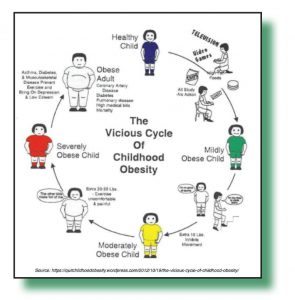By Juhee Shah, Team Manager and Health and Fitness Coach for Greatness Fitness
It is a sunny day and the street in front of my house is full of neighborhood kids riding bikes, throwing frisbees, and playing fetch with their dogs. This is a re-occurring scene from my childhood. Most evenings and weekends, my friends and I would be outside engaged in physical activities. In this scene, I do not recall seeing one obese kid. Today, childhood obesity is a serious global public health problem, and we do not often see scenes like this anymore. According to the Center for Disease Control and Prevention, about 30% of children and teens in the United States are overweight or obese. According to the World Health Organization, the number of overweight or obese infants and young children is 42 million globally. These numbers reflect the habits and environment of the youth today:
1) Dietary patterns
consuming more calories than expending
decrease in consumption of nutrients needed for a healthy diet
increased portion sizes
2) Lack of physical activity
increased screen time (TV, video games, cell phone, iPad)
decreased physical education in school
decreased activity at home and in day-to-day life
3) Family
learning poor health behaviors from parents
4) Socioeconomic status
inability to take part in physical activities
limited access to healthy foods
parents with little or no education are sometimes unaware about proper nutrition and healthy eating habits
5) Psychological factors
overeating to cope with emotional problems or boredom
6) Advertising
aggressive marketing of unhealthy foods, including those high in calories, sugar, salt and fat and low in nutrients
Being overweight or obese greatly affects a child’s life – both physically and emotionally. Serious physical conditions that can develop as a result of being obese include:
7) Insulin resistance: an early sign of type 2 diabetes
8) Metabolic syndrome: includes high blood pressure, high blood sugar, high triglycerides, low HDL cholesterol and high abdominal fat (conditions that can put children at risk for developing heart disease, diabetes and other health problems)
9) High cholesterol and high blood pressure: can lead to heart attack and stroke later in life
10) Asthma
11) Sleep disorders
12) Musculoskeletal disorders: includes osteoarthritis
13) Fatty liver disease
14) Cancers
15) Early puberty/menstruation
Childhood and adolescence is a time for children to grow, experience change, and develop into their adult self. Emotional problems, such as depression, behavioral and learning problems (anxiety and poor social skills) and low-self esteem and bullying, caused by weight problems can greatly affect the course children’s lives and keep them from reaching their potential.
Growing up with these health problems often results in an unhealthy adult life, with these same or worsening conditions. In order to combat obesity and these harmful conditions, the U.S. Department of Health and Human Services recommend that children and adolescents get at least 60 minutes oh physical activity everyday. The majority of this time should be moderate (5 or 6 on a 0 to 10 scale) to vigorous (7 to 8 on a 0 to 10 scale) intensity aerobic activity, with 3 days per week being all vigorous intensity. Part of the 60 minutes per day should include muscle and bone strengthening activity on 3 days per week. Most importantly, kids should participate in age-appropriate and enjoyable activities that fit these recommendations.
Prevention of obese children is possible and it all starts at home.
Prevention of obese children is possible and it all starts at home. Personally, from a young age, I was always engaged in sports. I played tennis and took Tae Kwon Do lessons starting at age 7. From childhood, I always gravitated toward physical activity, due to my love for these sports and the healthy lifestyle I led. This experience sparked my interest in fitness and nutrition. I started my doing my own reading and research about the health field in high school. I spent most of my time outside of school playing tennis, practicing Tae Kwon Do, working out by myself and reading about fitness and nutrition. Ten years later, I have earned a bachelors and masters degree in exercise physiology and am now building a career in the fitness world. My personal story is a direct result of my parents exposing me to an active lifestyle and healthy eating habits. While not everyone will develop the same passion in fitness as I did, parents can have a huge impact on their child’s lifestyle habits from a young age, by creating a healthy and active home environment. The best way they can do this is leading by example.
Find out more about how parents can set a healthy example in next month’s issue!
Sources: www.cdc.gov, www.obesity.org, www.who.int, www.mayoclinic.org, www.obesityaction.org
Juhee Shah is the Team Manager and Health and Fitness Coach for Greatness Fitness. She has both a B.S. in Kinesiology and a M.S. in Exercise Physiology. Juhee has received her certifications from the National Academy of Sports Medicine. She is a certified Personal Trainer.
Related posts
Newsletter Subscribe
Newest Posts
Set Up a Parental Control for Online Safety
Have you ever wondered how long your children spend in front of a device without your supervision? Yes, it is…
Adopt A Life, Save A Life
By Jeff Ashin, CEO, Young-Williams Animal Center. Photo by: Young-Williams Animal Center Are you or your child thinking of adding…



